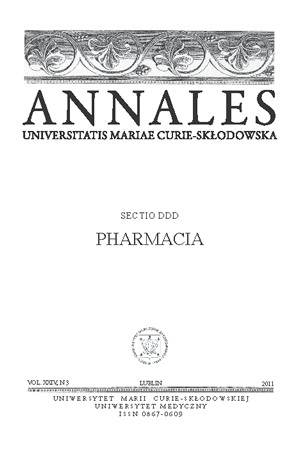Interaction of pregabalin with valproate in the mouse maximal electroshock-induced seizure model: an isobolographic analysis
DOI:
https://doi.org/10.12923/Keywords:
Pregabalin, valproate, isobolographic analysis, maximal electroshock, pharmacodynamic/pharmacokinetic interactionAbstract
The aim of this study was to characterize the interaction between pregabalin (PGB – a third-generation antiepileptic drug) and valproate (VPA – a classical antiepileptic drug) in the maximal electroshock (MES)-induced seizure model in mice by using the type I isobolographic analysis for non-parallel dose-response relationship curves (DRRCs). Tonic hind limb extension (seizure activity) was evoked in adult male albino Swiss mice by a current (25mA, 500V, 50Hz, 0.2s stimulus duration) delivered via auricular electrodes. In the mouse MES model, PGB administered singly had its DRRC non-parallel to that for VPA. According to type I isobolographic analysis for non-parallel DRRCs, the combination of PGB with VPA at the fixed-ratio of 1:1 exerted additive interaction. Pharmacokinetic studies revealed that PGB had no impact on total brain concentrations of VPA in experimental animals. Moreover, PGB, VPA and their combination at the fixed-ratio of 1:1 did not alter motor performance, long-term memory or skeletal muscular strength in experimental animals. In conclusion, the additive interaction between PGB and VPA is worthy of consideration while extrapolating the results from this preclinical study to clinical settings.
References
1. Ben-Menachem E.: Pregabalin pharmacology and its relevance to clinical practice. Epilepsia, 45 Suppl 6, 13, 2004.
2. Boissier J.R., Tardy J., Diverres J.C.: Une nouvelle méthode simple pour explorer l’action tranquilisante: le test de la cheminée. (in French) Med. Exp. (Basel) 3, 81, 1960.
3. Borowicz K.K., Świąder M., Łuszczki J., et al.: Effect of gabapentin on the anticonvulsant activity of antiepileptic drugs against electroconvulsions in mice: an isobolographic analysis. Epilepsia, 43, 956, 2002.
4. Brodie M.J.: Pregabalin as adjunctive therapy for partial seizures. Epilepsia, 45 Suppl 6, 19, 2004.
5. French J.A., Kugler A.R., Robbins J.L., et al.: Dose-response trial of pregabalin adjunctive therapy in patients with partial seizures. Neurology, 60, 1631, 2003.
6. Litchfield J.T., Wilcoxon F.: A simplified method of evaluating dose-effect experiments. J. Pharmacol. Exp. Ther. 96, 99, 1949.
7. Löscher W., Fassbender C.P., Nolting B.: The role of technical, biological and pharmacological factors in the laboratory evaluation of anticonvulsant drugs. II. Maximal electroshock seizure models. Epilepsy Res. 8, 79, 1991.
8. Łuszczki J.J., Antkiewicz-Michaluk L., Czuczwar S.J.: Isobolographic analysis of interactions between 1-methyl-1,2,3,4-tetrahydroisoquinoline and four conventional antiepileptic drugs in the mouse maximal electroshock-induced seizure model. Eur. J. Pharmacol. 602, 298, 2009.
9. Łuszczki J.J., Filip D., Czuczwar S.J.: Additive interactions of pregabalin with lamotrigine, oxcarbazepine and topiramate in the mouse maximal electroshock-induced seizure model: a type I isobolographic analysis for non-parallel dose-response relationship curves. Epilepsy Res. 91, 166, 2010.
10. Łuszczki J.J.: Additive interaction of pregabalin with phenytoin in the mouse maximal electroshock-induced seizure model: an isobolographic analysis. Ann. UMCS Sect. DDD 22, 31, 2009.
11. Łuszczki J.J.: Interaction of pregabalin with carbamazepine in the mouse maximal electroshock-induced seizure model: a type I isobolographic analysis for non-parallel dose-response relationship curves. Adv. Med. Sci. 55, 43, 2010.
12. Łuszczki J.J.: Interactions between pregabalin and phenobarbital in the mouse maximal electroshock-induced seizure model: an isobolographic analysis. J. Pre-Clin. Clin. Res. 3, 103, 2009.
13. Łuszczki J.J.: Isobolographic analysis of interaction between drugs with nonparallel dose-response relationship curves: a practical application. Naunyn-Schmiedebergs Arch. Pharmacol. 375, 105, 2007.
14. Macdonald R.L., Greenfield L.J.: Mechanisms of action of new antiepileptic drugs. Curr. Opin. Neurol. 10, 121, 1997.
15. Meyer O.A., Tilson H.A., Byrd W.C., et al.: A method for the routine assessment of fore- and hindlimb grip strength of rats and mice. Neurobehav. Toxicol. 1, 233, 1979.
16. Tallarida R.J.: An overview of drug combination analysis with isobolograms. J. Pharmacol. Exp. Ther. 319, 1, 2006.
17. Taylor C.P., Angelotti T., Fauman E.: Pharmacology and mechanism of action of pregabalin: the calcium channel alpha2-delta (alpha2-delta) subunit as a target for antiepileptic drug discovery. Epilepsy Res. 73, 137, 2007.
18. Venault P., Chapouthier G., de Carvalho L.P., et al.: Benzodiazepine impairs and beta-carboline enhances performance in learning and memory tasks. Nature 321, 864, 1986.
19. Warner G., Figgitt D.P.: Pregabalin: as adjunctive treatment of partial seizures. CNS Drugs 19, 265, discussion 273, 2005.
Downloads
Published
Issue
Section
License
Copyright (c) 2011 Authors

This work is licensed under a Creative Commons Attribution-NonCommercial-NoDerivatives 3.0 Unported License.


